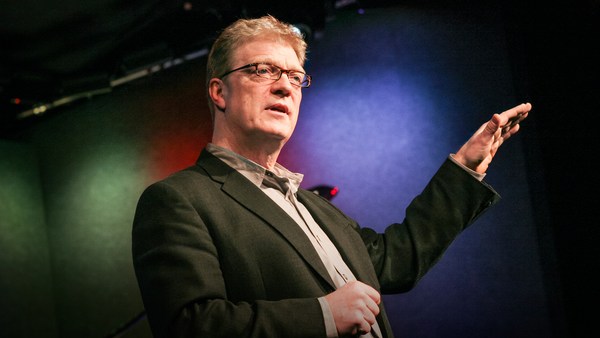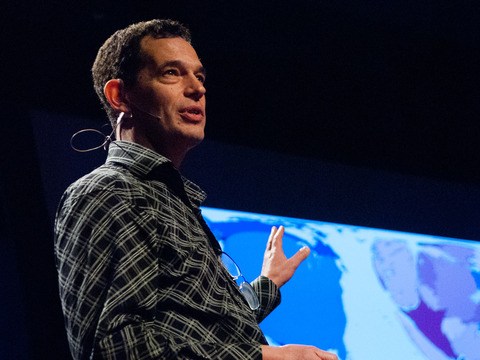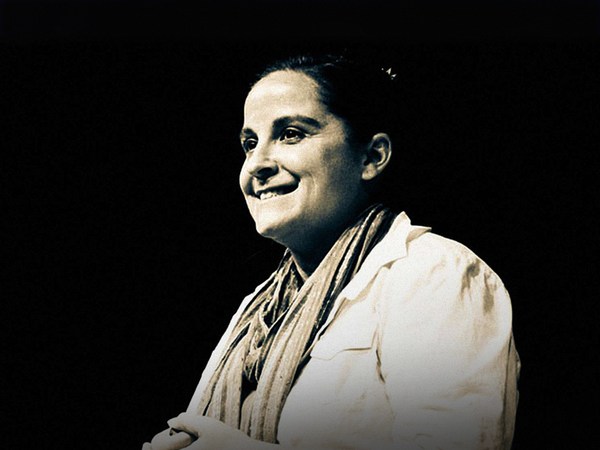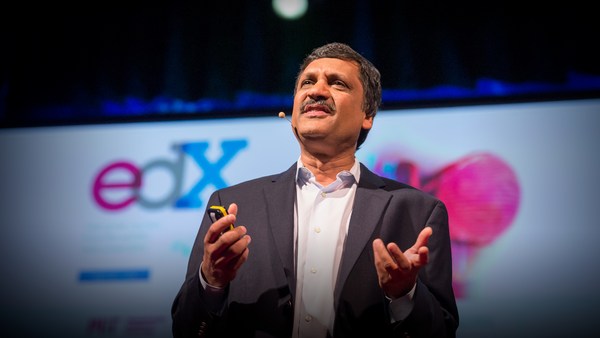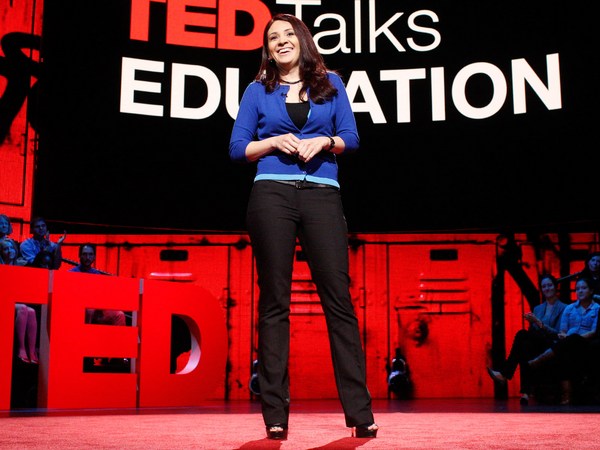Thank you so much everyone from TED, and Chris and Amy in particular. I cannot believe I'm here. I have not slept in weeks. Neil and I were sitting there comparing how little we've slept in anticipation for this. I've never been so nervous -- and I do this when I'm nervous, I just realized. (Laughter) So, I'm going to talk about sort of what we did at this organization called 826 Valencia, and then I'm going to talk about how we all might join in and do similar things.
Back in about 2000, I was living in Brooklyn, I was trying to finish my first book, I was wandering around dazed every day because I wrote from 12 a.m. to 5 a.m. So I would walk around in a daze during the day. I had no mental acuity to speak of during the day, but I had flexible hours. In the Brooklyn neighborhood that I lived in, Park Slope, there are a lot of writers -- it's like a very high per capita ratio of writers to normal people. Meanwhile, I had grown up around a lot of teachers. My mom was a teacher, my sister became a teacher and after college so many of my friends went into teaching. And so I was always hearing them talk about their lives and how inspiring they were, and they were really sort of the most hard-working and constantly inspiring people I knew.
But I knew so many of the things they were up against, so many of the struggles they were dealing with. And one of them was that so many of my friends that were teaching in city schools were having trouble with their students keeping up at grade level, in their reading and writing in particular. Now, so many of these students had come from households where English isn't spoken in the home, where a lot of them have different special needs, learning disabilities. And of course they're working in schools which sometimes and very often are under-funded. And so they would talk to me about this and say, "You know, what we really need is just more people, more bodies, more one-on-one attention, more hours, more expertise from people that have skills in English and can work with these students one-on-one."
Now, I would say, "Well, why don't you just work with them one-on-one?" And they would say, "Well, we have five classes of 30 to 40 students each. This can lead up to 150, 180, 200 students a day. How can we possibly give each student even one hour a week of one-on-one attention?" You'd have to greatly multiply the workweek and clone the teachers. And so we started talking about this. And at the same time, I thought about this massive group of people I knew: writers, editors, journalists, graduate students, assistant professors, you name it. All these people that had sort of flexible daily hours and an interest in the English word -- I hope to have an interest in the English language, but I'm not speaking it well right now. (Laughter) I'm trying. That clock has got me. But everyone that I knew had an interest in the primacy of the written word in terms of nurturing a democracy, nurturing an enlightened life. And so they had, you know, their time and their interest, but at the same time there wasn't a conduit that I knew of in my community to bring these two communities together.
So when I moved back to San Francisco, we rented this building. And the idea was to put McSweeney's -- McSweeney's Quarterly, that we published twice or three times a year, and a few other magazines -- we were going to move it into an office for the first time. It used to be in my kitchen in Brooklyn. We were going to move it into an office, and we were going to actually share space with a tutoring center. So we thought, "We'll have all these writers and editors and everybody -- sort of a writing community -- coming into the office every day anyway, why don't we just open up the front of the building for students to come in there after school, get extra help on their written homework, so you have basically no border between these two communities?" So the idea was that we would be working on whatever we're working on, at 2:30 p.m. the students flow in and you put down what you're doing, or you trade, or you work a little bit later or whatever it is. You give those hours in the afternoon to the students in the neighborhood.
So, we had this place, we rented it, the landlord was all for it. We did this mural, that's a Chris Ware mural, that basically explains the entire history of the printed word, in mural form -- it takes a long time to digest and you have to stand in the middle of the road. So we rented this space. And everything was great except the landlord said, "Well, the space is zoned for retail; you have to come up with something. You've gotta sell something. You can't just have a tutoring center." So we thought, "Ha ha! Really!" And we couldn't think of anything necessarily to sell, but we did all the necessary research. It used to be a weight room, so there were rubber floors below, acoustic tile ceilings and fluorescent lights. We took all that down, and we found beautiful wooden floors, whitewashed beams and it had the look -- while we were renovating this place, somebody said, "You know, it really kind of looks like the hull of a ship." And we looked around and somebody else said, "Well, you should sell supplies to the working buccaneer." (Laughter)
And so this is what we did. So it made everybody laugh, and we said, "There's a point to that. Let's sell pirate supplies." This is the pirate supply store. You see, this is sort of a sketch I did on a napkin. A great carpenter built all this stuff and you see, we made it look sort of pirate supply-like. Here you see planks sold by the foot and we have supplies to combat scurvy. We have the peg legs there, that are all handmade and fitted to you. Up at the top, you see the eyepatch display, which is the black column there for everyday use for your eyepatch, and then you have the pastel and other colors for stepping out at night -- special occasions, bar mitzvahs and whatever.
So we opened this place. And this is a vat that we fill with treasures that students dig in. This is replacement eyes in case you lose one. These are some signs that we have all over the place: "Practical Joking with Pirates." While you're reading the sign, we pull a rope behind the counter and eight mop heads drop on your head. That was just my one thing -- I said we had to have something that drops on people's heads. It became mop heads. And this is the fish theater, which is just a saltwater tank with three seats, and then right behind it we set up this space, which was the tutoring center. So right there is the tutoring center, and then behind the curtain were the McSweeney's offices, where all of us would be working on the magazine and book editing and things like that.
The kids would come in -- or we thought they would come in. I should back up. We set the place up, we opened up, we spent months and months renovating this place. We had tables, chairs, computers, everything. I went to a dot-com auction at a Holiday Inn in Palo Alto and I bought 11 G4s with a stroke of a paddle. Anyway, we bought 'em, we set everything up and then we waited. It was started with about 12 of my friends, people that I had known for years that were writers in the neighborhood. And we sat. And at 2:30 p.m. we put a sandwich board out on the front sidewalk and it just said, "Free Tutoring for Your English-Related and Writing-Related Needs -- Just Come In, It's All Free." And we thought, "Oh, they're going to storm the gates, they're gonna love it." And they didn't. And so we waited, we sat at the tables, we waited and waited. And everybody was becoming very discouraged because it was weeks and weeks that we waited, really, where nobody came in.
And then somebody alerted us to the fact that maybe there was a trust gap, because we were operating behind a pirate supply store. (Laughter) We never put it together, you know? And so then, around that time, I persuaded a woman named Nineveh Caligari, a longtime San Francisco educator -- she was teaching in Mexico City, she had all the experience necessary, knew everything about education, was connected with all the teachers and community members in the neighborhood -- I convinced her to move up from Mexico City where she was teaching. She took over as executive director. Immediately, she made the inroads with the teachers and the parents and the students and everything, and so suddenly it was actually full every day.
And what we were trying to offer every day was one-on-one attention. The goal was to have a one-to-one ratio with every one of these students. You know, it's been proven that 35 to 40 hours a year with one-on-one attention, a student can get one grade level higher. And so most of these students, English is not spoken in the home. They come there, many times their parents -- you can't see it, but there's a church pew that I bought in a Berkeley auction right there -- the parents will sometimes watch while their kids are being tutored. So that was the basis of it, was one-on-one attention. And we found ourselves full every day with kids. If you're on Valencia Street within those few blocks at around 2 p.m., 2:30 p.m., you will get run over, often, by the kids and their big backpacks, or whatever, actually running to this space,
which is very strange, because it's school, in a way. But there was something psychological happening there that was just a little bit different. And the other thing was, there was no stigma. Kids weren't going into the "Center-for-Kids-That-Need-More-Help," or something like that. It was 826 Valencia. First of all, it was a pirate supply store, which is insane. And then secondly, there's a publishing company in the back. And so our interns were actually working at the same tables very often, and shoulder-to-shoulder, computer-next-to-computer with the students.
And so it became a tutoring center -- publishing center, is what we called it -- and a writing center. They go in, and they might be working with a high school student actually working on a novel -- because we had very gifted kids, too. So there's no stigma. They're all working next to each other. It's all a creative endeavor. They're seeing adults. They're modeling their behavior. These adults, they're working in their field. They can lean over, ask a question of one of these adults and it all sort of feeds on each other. There's a lot of cross-pollination. The only problem, especially for the adults working at McSweeney's who hadn't necessarily bought into all of this when they signed up, was that there was just the one bathroom. (Laughter) With like 60 kids a day, this is a problem.
But you know, there's something about the kids finishing their homework in a given day, working one-on-one, getting all this attention -- they go home, they're finished. They don't stall. They don't do their homework in front of the TV. They're allowed to go home at 5:30 p.m., enjoy their family, enjoy other hobbies, get outside, play. And that makes a happy family. A bunch of happy families in a neighborhood is a happy community. A bunch of happy communities tied together is a happy city and a happy world. So the key to it all is homework! (Laughter) (Applause) There you have it, you know -- one-on-one attention.
So we started off with about 12 volunteers, and then we had about 50, and then a couple hundred. And we now have 1,400 volunteers on our roster. And we make it incredibly easy to volunteer. The key thing is, even if you only have a couple of hours a month, those two hours shoulder-to-shoulder, next to one student, concentrated attention, shining this beam of light on their work, on their thoughts and their self-expression, is going to be absolutely transformative, because so many of the students have not had that ever before. So we said, "Even if you have two hours one Sunday every six months, it doesn't matter. That's going to be enough." So that's partly why the tutor corps grew so fast.
Then we said, "Well, what are we going to do with the space during the day, because it has to be used before 2:30 p.m.?" So we started bringing in classes during the day. So every day, there's a field trip where they together create a book -- you can see it being typed up above. This is one of the classes getting way too excited about writing. You just point a camera at a class, and it always looks like this. So this is one of the books that they do. Notice the title of the book, "The Book That Was Never Checked Out: Titanic." And the first line of that book is, "Once there was a book named Cindy that was about the Titanic." So, meanwhile, there's an adult in the back typing this up, taking it completely seriously, which blows their mind.
So then we still had more tutors to use. This is a shot of just some of the tutors during one of the events. The teachers that we work with -- and everything is different to teachers -- they tell us what to do. We went in there thinking, "We're ultimately, completely malleable. You're going to tell us. The neighborhood's going to tell us, the parents are going to tell us. The teachers are going to tell us how we're most useful."
So then they said, "Why don't you come into the schools? Because what about the students that wouldn't come to you, necessarily, who don't have really active parents that are bringing them in, or aren't close enough?" So then we started saying, "Well, we've got 1,400 people on our tutor roster. Let's just put out the word." A teacher will say, "I need 12 tutors for the next five Sundays. We're working on our college essays. Send them in." So we put that out on the wire: 1,400 tutors. Whoever can make it signs up. They go in about a half an hour before the class. The teacher tells them what to do, how to do it, what their training is, what their project is so far. They work under the teacher's guide, and it's all in one big room. And that's actually the brunt of what we do is, people going straight from their workplace, straight from home, straight into the classroom and working directly with the students. So then we're able to work with thousands and thousands of more students. Then another school said, "Well, what if we just give you a classroom and you can staff it all day?"
So this is the Everett Middle School Writers' Room, where we decorated it in buccaneer style. It's right off the library. And there we serve all 529 kids in this middle school. This is their newspaper, the "Straight-Up News," that has an ongoing column from Mayor Gavin Newsom in both languages -- English and Spanish. So then one day Isabel Allende wrote to us and said, "Hey, why don't you assign a book with high school students? I want them to write about how to achieve peace in a violent world." And so we went into Thurgood Marshall High School, which is a school that we had worked with on some other things, and we gave that assignment to the students. And we said, "Isabel Allende is going to read all your essays at the end. She's going to publish them in a book. She's going to sponsor the printing of this book in paperback form. It's going to be available in all the bookstores in the Bay Area and throughout the world, on Amazon and you name it." So these kids worked harder than they've ever worked on anything in their lives, because there was that outside audience, there was Isabel Allende on the other end. I think we had about 170 tutors that worked on this book with them and so this worked out incredibly well. We had a big party at the end. This is a book that you can find anywhere. So that led to a series of these. You can see Amy Tan sponsored the next one, "I Might Get Somewhere." And this became an ongoing thing. More and more books.
Now we're sort of addicted to the book thing. The kids will work harder than they've ever worked in their life if they know it's going to be permanent, know it's going to be on a shelf, know that nobody can diminish what they've thought and said, that we've honored their words, honored their thoughts with hundreds of hours of five drafts, six drafts -- all this attention that we give to their thoughts. And once they achieve that level, once they've written at that level, they can never go back. It's absolutely transformative. And so then they're all sold in the store. This is near the planks. We sell all the student books. Where else would you put them, right? So we sell 'em, and then something weird had been happening with the stores. The store, actually -- even though we started out as just a gag -- the store actually made money. So it was paying the rent. And maybe this is just a San Francisco thing -- I don't know, I don't want to judge. But people would come in -- and this was before the pirate movies and everything! It was making a lot of money. Not a lot of money, but it was paying the rent, paying a full-time staff member there. There's the ocean maps you can see on the left.
And it became a gateway to the community. People would come in and say, "What the --? What is this?" I don't want to swear on the web. (Laughter) Is that a rule? I don't know. They would say, "What is this?" And people would come in and learn more about it. And then right beyond -- there's usually a little chain there -- right beyond, they would see the kids being tutored. This is a field trip going on. And so they would be shopping, and they might be more likely to buy some lard, or millet for their parrot, or, you know, a hook, or hook protector for nighttime, all of these things we sell. So the store actually did really well. But it brought in so many people -- teachers, donors, volunteers, everybody -- because it was street level. It was open to the public. It wasn't a non-profit buried, you know, on the 30th floor of some building downtown. It was right in the neighborhood that it was serving, and it was open all the time to the public. So, it became this sort of weird, happy accident.
So all the people I used to know in Brooklyn, they said, "Well, why don't we have a place like that here?" And a lot of them had been former educators or would-be educators, so they combined with a lot of local designers, local writers, and they just took the idea independently and they did their own thing. They didn't want to sell pirate supplies. They didn't think that that was going to work there. So, knowing the crime-fighting community in New York, they opened the Brooklyn Superhero Supply Company. This is Sam Potts' great design that did this. And this was to make it look sort of like one of those keysmith's shops that has to have every service they've ever offered, you know, all over there. So they opened this place. Inside, it's like a Costco for superheroes -- all the supplies in kind of basic form. These are all handmade. These are all sort of repurposed other products, or whatever. All the packaging is done by Sam Potts.
So then you have the villain containment unit, where kids put their parents. You have the office. This is a little vault -- you have to put your product in there, it goes up an electric lift and then the guy behind the counter tells you that you have to recite the vow of heroism, which you do, if you want to buy anything. And it limits, really, their sales. Personally, I think it's a problem. Because they have to do it hand on heart and everything. These are some of the products. These are all handmade. This is a secret identity kit. If you want to take on the identity of Sharon Boone, one American female marketing executive from Hoboken, New Jersey. It's a full dossier on everything you would need to know about Sharon Boone. So, this is the capery where you get fitted for your cape, and then you walk up these three steel-graded steps and then we turn on three hydraulic fans from every side and then you can see the cape in action. There's nothing worse than, you know, getting up there and the cape is bunching up or something like that. So then, the secret door -- this is one of the shelves you don't see when you walk in, but it slowly opens. You can see it there in the middle next to all the grappling hooks. It opens and then this is the tutoring center in the back. (Applause) So you can see the full effect!
But this is -- I just want to emphasize -- locally funded, locally built. All the designers, all of the builders, everybody was local, all the time was pro-bono. I just came and visited and said, "Yes, you guys are doing great," or whatever. That was it. You can see the time in all five boroughs of New York in the back. (Laughter) (Applause) So this is the space during tutoring hours. It's very busy. Same principles: one-on-one attention, complete devotion to the students' work and a boundless optimism and sort of a possibility of creativity and ideas. And this switch is flicked in their heads when they walk through those 18 feet of this bizarre store, right? So it's school, but it's not school. It's clearly not school, even though they're working shoulder-to-shoulder on tables, pencils and papers, whatever.
This is one of the students, Khaled Hamdan. You can read this quote. Addicted to video games and TV. Couldn't concentrate at home. Came in. Got this concentrated attention. And he couldn't escape it. So, soon enough, he was writing. He would finish his homework early -- got really addicted to finishing his homework early. It's an addictive thing to sort of be done with it, and to have it checked, and to know he's going to achieve the next thing and be prepared for school the next day. So he got hooked on that, and then he started doing other things. He's now been published in five books. He co-wrote a mockumentary about failed superheroes called "Super-Has-Beens." He wrote a series on "Penguin Balboa," which is a fighting -- a boxing -- penguin. And then he read aloud just a few weeks ago to 500 people at Symphony Space, at a benefit for 826 New York. So he's there every day. He's evangelical about it. He brings his cousins in now. There's four family members that come in every day.
So, I'll go through really quickly. This is L.A., The Echo Park Time Travel Mart: "Whenever You Are, We're Already Then." (Laughter) This is sort of a 7-Eleven for time travelers. So you see everything: it's exactly as a 7-Eleven would be. Leeches. Mammoth chunks. They even have their own Slurpee machine: "Out of Order. Come Back Yesterday." (Laughter) (Applause)
Anyway. So I'm going to jump ahead. These are spaces that are only affiliated with us, doing this same thing: Word St. in Pittsfield, Massachusetts; Ink Spot in Cincinnati; Youth Speaks, San Francisco, California, which inspired us; Studio St. Louis in St. Louis; Austin Bat Cave in Austin; Fighting Words in Dublin, Ireland, started by Roddy Doyle, this will be open in April. Now I'm going to the TED Wish -- is that okay?
All right, I've got a minute. So, the TED Wish: I wish that you -- you personally and every creative individual and organization you know -- will find a way to directly engage with a public school in your area and that you'll then tell the story of how you got involved, so that within a year we have a thousand examples -- a thousand! -- of transformative partnerships. Profound leaps forward! And these can be things that maybe you're already doing. I know that so many people in this room are already doing really interesting things. I know that for a fact. So, tell us these stories and inspire others on the website.
We created a website. I'm going to switch to "we," and not "I," hope: We hope that the attendees of this conference will usher in a new era of participation in our public schools. We hope that you will take the lead in partnering your innovative spirit and expertise with that of innovative educators in your community. Always let the teachers lead the way. They will tell you how to be useful. I hope that you'll step in and help out. There are a million ways. You can walk up to your local school and consult with the teachers. They'll always tell you how to help. So, this is with Hot Studio in San Francisco, they did this phenomenal job. This website is already up, it's already got a bunch of stories, a lot of ideas. It's called "Once Upon a School," which is a great title, I think. This site will document every story, every project that comes out of this conference and around the world. So you go to the website, you see a bunch of ideas you can be inspired by and then you add your own projects once you get started. Hot Studio did a great job in a very tight deadline. So, visit the site. If you have any questions, you can ask this guy, who's our director of national programs. He'll be on the phone. You email him, he'll answer any question you possibly want. And he'll get you inspired and get you going and guide you through the process so that you can affect change.
And it can be fun! That's the point of this talk -- it needn't be sterile. It needn't be bureaucratically untenable. You can do and use the skills that you have. The schools need you. The teachers need you. Students and parents need you. They need your actual person: your physical personhood and your open minds and open ears and boundless compassion, sitting next to them, listening and nodding and asking questions for hours at a time. Some of these kids just don't plain know how good they are: how smart and how much they have to say. You can tell them. You can shine that light on them, one human interaction at a time. So we hope you'll join us. Thank you so much.
